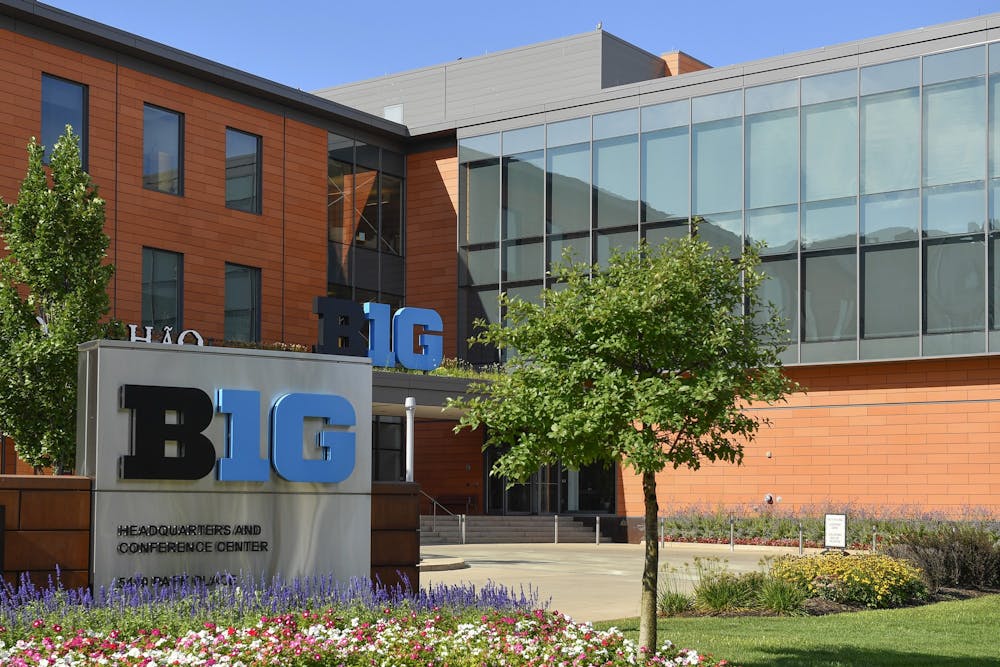You love watching sports. You love the Big Ten. I’m willing to bet you also love money, or at least begrudgingly accept the crushing weight of its importance in society.
Well, great news — those three cornerstones of your personality are now at center stage thanks to the seven-year, $7 billion media rights deal the Big Ten announced Aug. 18 in association with Fox, CBS and NBC.
By the time the contract expires in 2030, each member school is expected to net between $80 and $100 million annually. That will include the University of Southern California and UCLA, which plan to join the conference in 2024.
[Related: COLUMN: The addition of USC and UCLA to the Big Ten is important for sports other than football]
If you think that sounds like an absurd amount of money, it’s because it is.
How do you even conceptualize $7 billion? Is that good? It sure seems like a good deal to me, but any 10-figure contract is going to sound pretty sweet to someone who spends full minutes in the yogurt aisle debating whether he should buy the single-serving cups or the full tub to save on a price-per-ounce basis.
But let’s assume it’s a good deal. Congratulations, Big Ten — way to get your bread up. Now what?
For casual viewers of collegiate sports, this basically means more football and men’s basketball games on network television. Other sports will appear primarily on FS1 or the Big Ten Network, meaning your grandparents will still need to purchase a cable package if they want to catch a swim meet in between four-hour binges of Fox News.
Of course, the deal isn’t all about football. OK, I guess it’s mostly about football — my god, that is so much money — but that doesn’t mean we shouldn’t talk about the other sports.
Not only will CBS continue to air select men’s basketball games throughout the regular season and conference tournament, but for the first time, it will air the Big Ten women’s basketball tournament championship game.
I’m definitely not saying we should applaud the multibillion-dollar media conglomerate for doing the bare minimum in advancing women’s sports, but it would be cool to see a replay of Indiana graduate student guard Grace Berger draining a midrange shot in slow motion as the CBS NCAA basketball theme plays before cutting to a commercial.
The remaining non-revenue sports should get more exposure on cable channels as football and basketball partially migrate to network TV. They also get to exist, which wouldn’t necessarily be the case without the new media rights deal.
Indiana has been fortunate to navigate the past few years without having to cut any of its athletic programs. The contract’s annual payouts should afford that same luxury to schools that haven’t been as lucky.
Obviously, the thought of nearly 20 sports’ survival hinging on the performance of two or three is not particularly pleasant. Welcome to college athletics. If you want a hobby mostly devoid of moral quandaries or existential dread, can I suggest knitting?
However, the implications of the media rights deal aren’t all quite so murky.
You may have noticed thus far there has been no mention of ESPN. That’s fairly uncommon in college sports media considering ESPN currently has broadcasting rights to nine major NCAA conferences.
Pulling power from ESPN creates more competition among networks, theoretically leading to a better product for viewers. As you may have learned in U.S. history class, monopolies generally aren’t great. Luckily, this is America, where such an abuse of capitalism would never be allowed.
Instead, we’re blessed with a good, old-fashioned oligopoly, just like God or George Washington or whoever intended.
At this point, there’s one question that may still be rattling around in your head: does this mean schools are finally going to start paying players?
Look, I see why you might look at an industry that leverages the skills of student athletes to generate ludicrous amounts of revenue and think it’s a little gross to not pay those student athletes. But let’s not get ahead of ourselves.
I mean, just think of the poor, underserved university administrators. This is only $7 billion we’re talking about after all.






